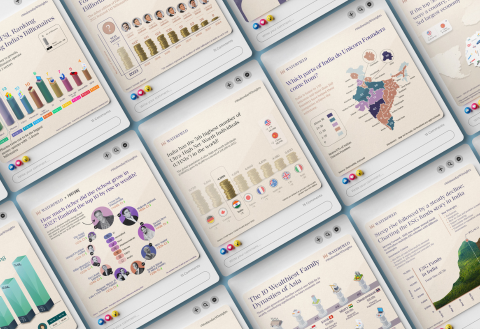Insight into 25 Key Wealth Trends in India
article • Investment Management

Waterfield Advisors
2024-02-02 | 5 minutes
India’s wealth story is witnessing an unprecedented rise. Be it millionaires, centimillionaires, or billionaires, the numbers are rising on all fronts, which has multiple implications for various industries such as wealth management, luxury goods, real estate, luxury travel and accommodation, and more. Moreover, post pandemic, and with large scale digital adoption in the country, there is a greater financialisation of savings, a startup revolution, and growing interest in alternative investment opportunities.
We have compiled a set of infographics that tap into a variety of wealth trends developing in the country and help develop a data-backed holistic view. From the number of UHNIs, to forecasts by global financial institutions, to investment trends in art and sports franchises, this compilation of WInsights is a must read!
#1 Number of UHNIs in India
India now has the 5th largest number of ultra-high-net-worth individuals (UHNIs) in the world, springing ahead of some of the world's developed economies.
Though US and China are still far ahead, this number, which is touted to only increase in the coming years, has major implications for the wealth ecosystem.
#2 Key Concerns for Asia-Pacific Family Offices
Against the backdrop of volatile market conditions, it comes as no surprise that managing market risks (73%) and preserving the value of assets (70%) have emerged as the two major focal points. The ever-present threats of rising inflation and interest rates demand astute risk management strategies to navigate these turbulent waters.
However, it is surprising to note the lowest concerns of family offices - cyber security protection (17%), and transition to next-generation (13%).
#3 Billionaire Cities of the World
Mumbai, the financial capital of India, has the 10th highest number of billionaires in the world!
With 39 resident billionaires, Mumbai is now leading cities like Dubai, Hangzhou, Istanbul, Sao Paolo, and Paris, as per the annual Billionaire Census by Wealth-X, a US-based leading global wealth information and business analysis firm.
#4 Sporting Legacies of India’s Prominent Family Business Owners
In India’s top 3 domestic tournaments (Indian Premier League, Indian Super League, and Pro Kabaddi League), family businesses have a majority ownership in at least 4 teams.
While the JSW Group, RPSG Group, and GMR Group have sporting teams across different formats, the Ambanis, as always, have gone a notch higher, and are co-promoters of the entire football league itself (ISL).
#5 Family Offices Investing in Startups
The story of family office investments in startups shows a rising graph over the last decade. And in 2022, India was the 3rd biggest focus country for these investors.
The US, expectedly, is leading the list by a considerable margin. China ranks 2nd in terms of overall VC investments, but the absence of family office-backed investments reflects a higher degree of perceived risks, especially post-covid. Family offices' strong focus on India reflects India's large number of attractive tech-driven startups.
#6 Charting the ESG Funds story in India
Following a steep rise, the ESG funds have started stagnating in the last FY, driven by -
a. decline in valuation, and
b. net outflow of INR 1,393 crore in 2022-23
#7 The 10 Most Expensive Indian Artworks Sold in FY23
In FY23, Indian artworks witnessed a record-breaking INR 1,145.5 Crores of turnover at auctions through the sale of 3,833 works. The average price of the art pieces sold in FY23 stood at INR 29.9 Lakhs.
#8 If the top 500 family businesses of the world were a country
If 500 of the largest family businesses in the world were a nation, that nation would be the 3rd largest economy in the world!
As per the 2023 EY and University of St. Gallen Family Business Index, the largest family enterprises are growing faster than the global economy. The 500 largest family businesses generated $8.02 Trillion in revenue in 2022, an increase of 10% from 2021. Between them, these companies employ 24.52 million people and are distributed across 47 countries.
India is not far behind when it comes to family businesses. For the first time ever, an Indian family enterprise, Reliance Industries, has made it to the top 10 companies in the index. Additionally, India is the fourth largest contributor to the Index in terms of the combined revenue of its companies ($365 billion).
#9 India’s V-Shaped Economic Rise Since Independence
6th to 12th to 5th and now racing to 3rd, India's global economic standings has seen a v-shaped rise since independence. Beyond GDP, India has seen exponential progress in key metrics such as per capita income, literacy rate, gross savings, and life expectancy.
On India’s ambitious path to becoming a developed economy by 2047, 3 factors will be key -
- Demographic Dividend
- Digital Economy
- Diplomatic Ties
#10 Wealthiest Asian Family Business Dynasties
Each of the top 10 wealthiest family business dynasties in Asia are currently managed by the third generation of the family or beyond, a solid testimony to the resilience of family-owned enterprises. It is also interesting to note the diverse industries that these tycoons have built their empires on - from construction and agriculture to tobacco, jewels, electronics and energy drinks.
In an extended ranking of the top 20 such family dynasties, 5 Indian families make the cut - Ambani (#1), Mistry (#4), Birla (#15), Jindal (18), Hinduja (#19).
#11 India’s Richest Person From 2004 - 2023
From just 9 to 142, India's ultra wealthy population has seen a meteoric rise, now ranking ahead of many developed economies of the world. There were 142 billionaires (USD) in India as of September 2022, as per the debut edition of Fortune India - Waterfield Advisors India's Dollar Billionaires Study, launched in 2022.
Mukesh Ambani lost out to the title of ‘India’s Richest’ in 2022, after a 5-year-streak as Gautam Adani saw a meteoric rise in wealth.
#12 Key Highlights from Fortune - Waterfield Ranking of India’s Dollar Billionaires 2023
The 2023 edition of Fortune India - Waterfield Advisors Ranking of India's Dollar Billionaires shows considerable growth in the country's billionaire count.
The list sees 23 new entrants, while 8 names dropped off, increasing the total tally from 142 to 157 and the collective wealth from $832 Bn to $843 Bn. As was widely expected, Mukesh Ambani reclaims his throne as India's richest person.
#13 Industries Crafting India’s Billionaires
The Fortune India - Waterfield Advisors ranking of India's billionaires shows that diversification has been key to growth. Diversified groups account for 24 out of 157 Indian dollar billionaires, contributing 38.18% of the total wealth.
Among standalone industries, the pharma industry contributes the highest share (14.84%) of the total wealth. Pharma continues to grow post-COVID as promoters reap the benefits of growth in India and new launches in key markets such as the US and specific measures to improve profitability. The numbers explain the 66.24% jump in wealth of Cyrus Soli Poonawalla from 2022, who is the highest riser in the list.
#14 Top 10 Indian Wealth Risers in 2023
Cyrus Poonawalla jumped from 6th to 4th in this year's Fortune India - Waterfield Advisors ranking of India's billionaires, backed by an increase in total wealth of a whooping ₹1.08 lakh crores.
The exponential growth of Cyrus Poonawalla's wealth is driven by the valuation of the Serum Institute of India. The Poonawalla Group flagship's profit rose ~3x to ₹11,116 crore in FY22, with its Covishield vaccine cornering 79% share (174.52 crore doses) of the total 220.07 crore doses administered in the country through the course of the pandemic. Beyond SII, the financial services arm of the group accounts for 6.5% of the total value.
#15 Growth of India’s Equity Markets From 2005 - 2075
Goldman Sachs' latest projections identifies India's equity market to grow the fastest globally in the coming years.
According to the latest Goldman Sachs Research, India's global market cap share will rise from a little under 3% in 2022 to 8% in 2050, and 12% in 2075. Moreover, within EMs, while China’s relative EM share is expected to decline from 40% in 2022 to about 30% in 2050, India’s is projected to rise from 12% in 2022 to around 17% in 2050.
#16 Family Philanthropy to Meet Sustainable Development Goals
A deep dive into the philanthropic ecosystem in India shows that giving has steadily been increasing across all cohorts except one - Family Philanthropy.
Philanthropic giving by UHNI, HNI and Affluent families is the key to increase social sector funding and meet our SDG goals by 2030. The HNI and UHNI families can play a particularly important role in strengthening the philanthropic infrastructure by providing flexible and long-term capital.
#17 Projecting Economic Growth of Major Global Economies
The IMF released its updated World Economic Outlook earlier this month, and it spotlights India as the most stable major economy amidst slowing global growth.
Advanced economies are expected to slow from 2.6% in 2022 to 1.5% in 2023 and 1.4% in 2024 as policy tightening starts to bite. Emerging markets and developing economies are projected to have a modest decline in growth from 4.1% in 2022 to 4.0% in both 2023 and 2024.
#18 Rise of Women Mutual Fund Investors in India
The number of women investors in the mutual fund industry rose to 74.49 lakh at the end of December 2022 from 46.99 lakh in December 2019.
The dissection of the numbers suggests that the growth has been holistic and not majorly skewed due to a particular section of the community. The 18-24-year-old women investors have been the most bullish on mutual funds as their number grew 4x in 3 years.
The jump in numbers is observed across the top 30 cities (T30) and the cities beyond those (B30). In T30 locations, the number of women investors surged almost 50 per cent to 41.7 lakh in December 2022 from 27.94 lakh in December 2019. The jump from B30 locations was much higher - 32.3 lakh from 19.05 lakh.
#19 Growth of India’s Luxury Goods Market
If the Jio World Plaza launch was anything to go by, India is rapidly becoming home to some of the most premium global brands, and data backs that narrative. As per Euromonitor International, the recovery post-covid has been steady, rising from $6 Bn in 2021 to $8.5 Bn in 2023. Moreover, a Bain & Co. report estimates the segment to expand 3.5x by the end of the decade.
The positive estimations are backed by India's strongly growing UHNI and HNI community. Iconic names across categories like Laderach, Galeries Lafayette, Valentino, and Balenciaga have partnered with Indian business owners in the past few months. Delhi and Mumbai - the two luxury capitals of India, will be witnessing the opening of many prominent names in the coming months.
#20 Consumption of Gold Jewellery Globally
Gold is intrinsic to India's culture and the numbers back the sentiment. In 2022, India was the largest consumer of gold jewellery.
Driven by weddings, religious festivities, and agricultural prosperity, gold remains a staple of Indian investment and celebration. Indians heavily invested in gold coins and bars as well, making India the 2nd largest market for the same, only behind China.
As an asset class, gold is perceived as a safe haven, and has proven to be a reliable hedge against inflation. In the US, in 8 of the last 10 recessions, gold has outperformed S&P 500 index. On a five-year horizon, gold has been the best-performing asset class while markets and real estate have been impacted by global turbulences.
#21 Sensex Performance on Diwali Muhurat Trading Days
The unique concept of Diwali Muhurat Trading has been a celebratory period for investors over the last 10 years and the trend continued in 2023 as well.
Sensex clocked a healthy gain of 355 points (~0.6%), which was marginally lesser than last year's record high of 524.5 points. This Wednesday, we are tracking the Sensex movement over the previous 10 years of the Diwali Muhurat trading session.
#22 Growing AuM of AIFs in India
The assets under management (AuM) of Alternative Investment Funds (AIFs) in India have increased 4x to $101 Bn in the last 4 years.
AIFs provide investors with a varied choice of alternative assets such as private equity, real estate, and infrastructure, and offer diversification beyond the traditional investment options. Yet another implication of the growing number of HNIs in the country has been the rise of AIFs as a critical financial instrument.
Category II of AIFs is the dominant category of AIFs in India. At the end of March 2023, commitments totalling US$84b were primarily made with Category II funds, 33.66% more than last year. Category II AIFs consist of real estate funds, private equity funds (PE funds), funds for distressed assets, etc.
#23 Growing AuM of Passive Investment Funds in India
Passive investing is gaining traction among Indian investors. In the last 5 years, the assets under management (AuM) of Exchange-Traded Funds (ETFs) and Index Funds witnessed a CAGR) of 38% and 129%, respectively.
In 2019, passive funds accounted for ~6% of the overall AuM. Today, the number has risen to ~17%. The flows are predominantly from corporates and HNIs.
#24 Mumbai is World #1 in Number of IPOs in 2023
In 2023, Mumbai led the world in terms of the number of new stock market listings, expected to rise 45% year-on-year to 209.
The number of IPOs in the financial centres of China is expected to fall this year - 33% to 126 in Shenzhen, 36% to 99 in Shanghai and 19% to 61 in Hong Kong. The NSE and BSE still lag the mainland Chinese bourses in IPO proceeds, but their new listings are on course to raise more money this year than those of Hong Kong. This reflects the strength of India's economy, the government's push for infrastructure and the growing appetite of Indian investors for equities.
#25 Where do Founders of Indian Unicorn Startups Hail From?
Since the first unicorn in 2011, India has produced more than 110 unicorns, the 3rd highest number in the world. It is fascinating to note that almost every state of our diverse country has produced one or more unicorn founders.
Maharashtra (40) and Delhi (36) contribute the largest numbers, followed by Uttar Pradesh (26), Rajasthan (23), and Tamil Nadu (22). The 6th to 10th spots are taken by -
#6 Madhya Pradesh (13),
#7 Punjab, Gujarat (11),
#9 Telangana (9),
#10 Haryana, West Bengal and Karnataka (8).














